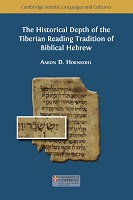The Historical Depth of the Tiberian Reading Tradition of Biblical Hebrew
| dc.contributor.author | Hornkohl, Aaron D. | |
| dc.date.accessioned | 2023-02-07T09:26:52Z | |
| dc.date.available | 2023-02-07T09:26:52Z | |
| dc.date.issued | 2023 | |
| dc.identifier | OCN: 1369663912 | |
| dc.identifier.uri | https://library.oapen.org/handle/20.500.12657/61184 | |
| dc.description.abstract | This volume explores an underappreciated feature of the standard Tiberian Masoretic tradition of Biblical Hebrew, namely its composite nature. Focusing on cases of dissonance between the tradition’s written (consonantal) and reading (vocalic) components, the study shows that the Tiberian spelling and pronunciation traditions, though related, interdependent, and largely in harmony, at numerous points reflect distinct oral realisations of the biblical text. Where the extant vocalisation differs from the apparently pre-exilic pronunciation presupposed by the written tradition, the former often exhibits conspicuous affinity with post-exilic linguistic conventions as seen in representative Second Temple material, such as the core Late Biblical Hebrew books, the Dead Sea Scrolls, Ben Sira, rabbinic literature, the Samaritan Pentateuch, and contemporary Aramaic and Syriac material. On the one hand, such instances of written-reading disharmony clearly entail a degree of anachronism in the vocalisation of Classical Biblical Hebrew compositions. On the other, since many of the innovative and secondary features in the Tiberian vocalisation tradition are typical of sources from the Second Temple Period and, in some cases, are documented as minority alternatives in even earlier material, the Masoretic reading tradition is justifiably characterised as a linguistic artefact of profound historical depth. | en_US |
| dc.language | English | en_US |
| dc.relation.ispartofseries | Cambridge Semitic Languages and Cultures | en_US |
| dc.subject.classification | thema EDItEUR::Q Philosophy and Religion::QR Religion and beliefs::QRA Religion: general::QRAX History of religion | en_US |
| dc.subject.classification | thema EDItEUR::Q Philosophy and Religion::QR Religion and beliefs::QRM Christianity::QRMF Christianity: sacred texts and revered writings::QRMF1 Bibles::QRMF13 New Testaments | en_US |
| dc.subject.classification | thema EDItEUR::Q Philosophy and Religion::QR Religion and beliefs::QRM Christianity::QRMF Christianity: sacred texts and revered writings::QRMF1 Bibles::QRMF19 Bible readings, selections and meditations | en_US |
| dc.subject.classification | thema EDItEUR::C Language and Linguistics::CF Linguistics::CFF Historical and comparative linguistics | en_US |
| dc.subject.other | standard Tiberian Masoretic tradition;Hebrew Bible;written components (consonantal);reading components (vocalic);Tiberian spelling;Tiberian pronunciation | en_US |
| dc.title | The Historical Depth of the Tiberian Reading Tradition of Biblical Hebrew | en_US |
| dc.type | book | |
| oapen.identifier.doi | 10.11647/OBP.0310 | en_US |
| oapen.relation.isPublishedBy | 23117811-c361-47b4-8b76-2c9b160c9a8b | en_US |
| oapen.relation.isbn | 9781800649804 | en_US |
| oapen.relation.isbn | 9781800649811 | en_US |
| oapen.collection | ScholarLed | en_US |
| oapen.series.number | 17 | en_US |
| oapen.pages | 558 | en_US |
| oapen.place.publication | Cambridge | en_US |

